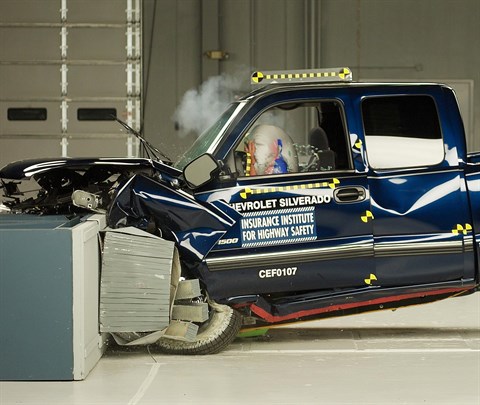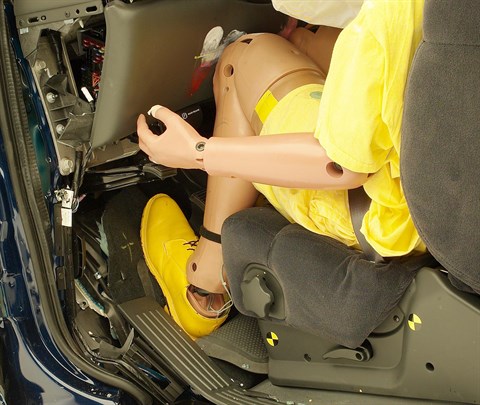Moderate overlap front: original test
Rating applies to 1999-2006 models
Tested vehicle: 2001 Chevrolet Silverado 1500 LS ext cab
The Chevrolet Silverado 1500 and GMC Sierra 1500 were redesigned during the 1999 model year (the previous design extended into the early 1999 model year). The Classic nameplate was added in the 2007 model year to distinguish what effectively are carryover 2006 models from the redesigned 2007 Silverado 1500 and Sierra 1500.
Note: These ratings do NOT apply to the redesigned 2007 Chevrolet Silverado 1500 and GMC Sierra 1500.
| Evaluation criteria | Rating |
|---|---|
| Overall evaluation | |
| Structure and safety cage | |
| Driver injury measures | |
| Head/neck | |
| Chest | |
| Leg/foot, left | |
| Leg/foot, right | |
| Driver restraints and dummy kinematics Dummy movement wasn't well controlled. After the dummy moved forward into the airbag, its head dropped down below the window sill. Then the head rebounded upward and hit the shoulder belt housing, which is mounted directly to the seat back. There was far too much upward movement of the steering wheel. Also, the driver seat came loose on one of its tracks and moved rearward slightly on the right side, where the safety belt buckle is anchored. |
|

Action shot taken during the frontal offset crash test.

The dummy's position in relation to the steering wheel and instrument panel after the crash test indicates the driver's survival space wasn't maintained well.

Poor control of dummy movement allowed the head to drop below the window sill.

Footwell and instrument panel intrusion, in combination with the driver seat pitching forward, greatly reduced the space for the dummy's legs and feet.
Measures of occupant compartment intrusion on driver side
| Evaluation criteria | Measurement |
|---|---|
| Test ID | CEF0107 |
| Footwell intrusion | |
| Footrest (cm) | 28 |
| Left (cm) | 28 |
| Center (cm) | 26 |
| Right (cm) | 23 |
| Brake pedal (cm) | 24 |
| Instrument panel rearward movement | |
| Left (cm) | 11 |
| Right (cm) | 11 |
| Steering column movement | |
| Upward (cm) | 15 |
| Rearward (cm) | 4 |
| A-pillar rearward movement (cm) | 9 |
Driver injury measures
| Evaluation criteria | Measurement |
|---|---|
| Test ID | CEF0107 |
| Head | |
| HIC-15 | 361 |
| Peak gs at hard contact | 22 |
| Neck | |
| Tension (kN) | 1.9 |
| Extension bending moment (Nm) | 66 |
| Maximum Nij | 0.59 |
| Chest maximum compression (mm) | 23 |
| Legs | |
| Femur force - left (kN) | 4.3 |
| Femur force - right (kN) | 5.6 |
| Knee displacement - left (mm) | 0 |
| Knee displacement - right (mm) | 0 |
| Maximum tibia index - left | 0.66 |
| Maximum tibia index - right | 0.77 |
| Tibia axial force - left (kN) | 2.1 |
| Tibia axial force - right (kN) | 3.9 |
| Foot acceleration (g) | |
| Left | 112 |
| Right | 140 |
Head restraints & seats
Seat type: Seats with adjustable head restraints
| Overall evaluation | |
|---|---|
| Dynamic rating | |
| Seat/head restraint geometry |
| Seat type | Seats with adjustable head restraints |
|---|---|
| Geometry | |
| Backset (mm) | 60 |
| Distance below top of head (mm) | 100 |
| Seat design parameters | |
| Pass/fail | Fail |
| Max T1 acceleration (g) | 0.0 |
| Head contact time (ms) | |
| Force rating | 0 |
| Neck forces | |
| Max neck shear force (N) | |
| Max neck tension (N) | |
Seat type: Seats with fixed head restraints
| Overall evaluation | |
|---|---|
| Dynamic rating | |
| Seat/head restraint geometry |
| Seat type | Seats with fixed head restraints |
|---|---|
| Geometry | |
| Backset (mm) | 70 |
| Distance below top of head (mm) | 125 |
| Seat design parameters | |
| Pass/fail | Fail |
| Max T1 acceleration (g) | 0.0 |
| Head contact time (ms) | |
| Force rating | 0 |
| Neck forces | |
| Max neck shear force (N) | |
| Max neck tension (N) | |
About the head restraint & seat test
Currently, IIHS tests apply only to front seats.